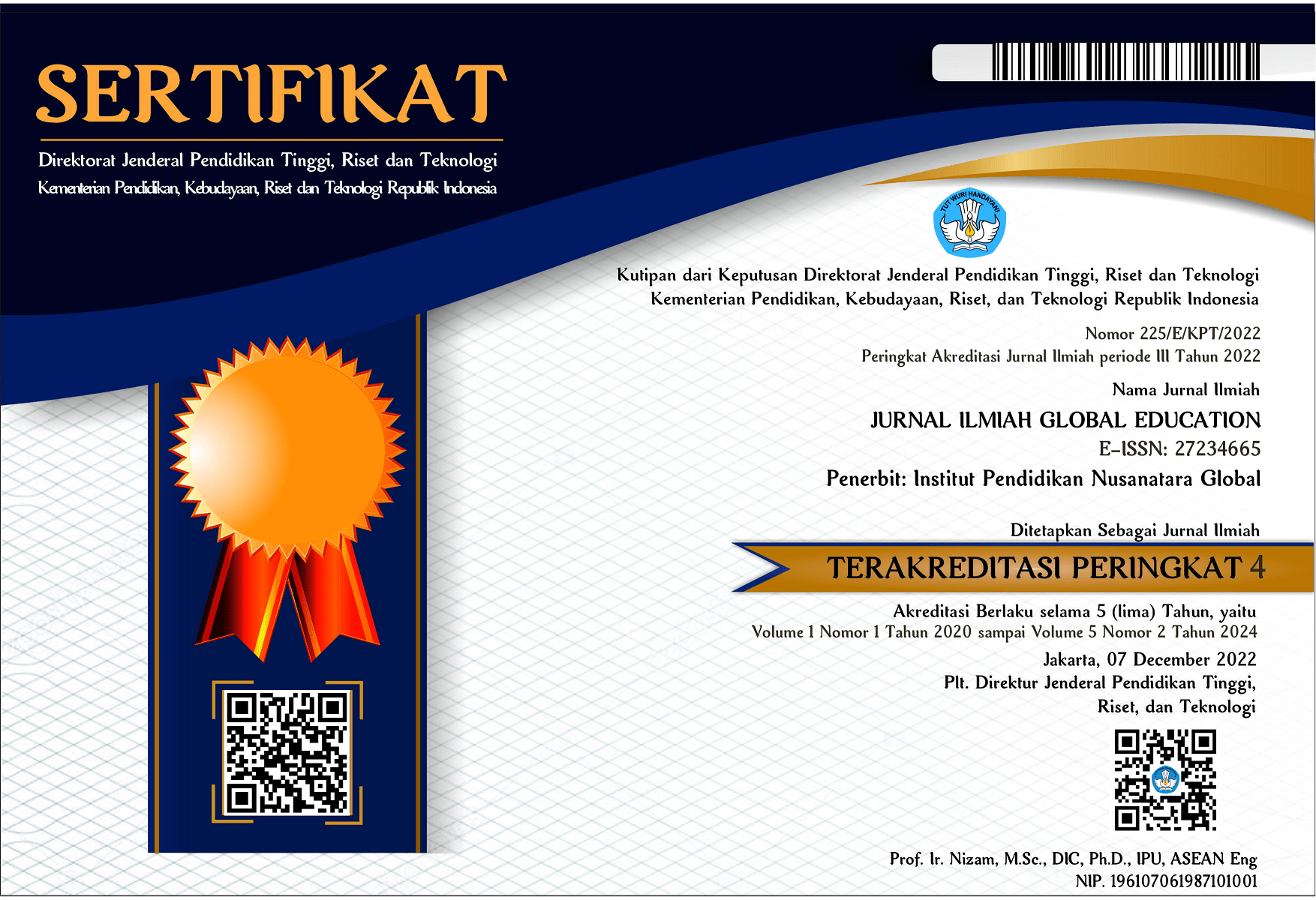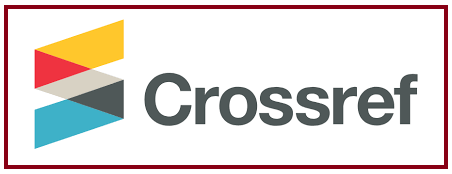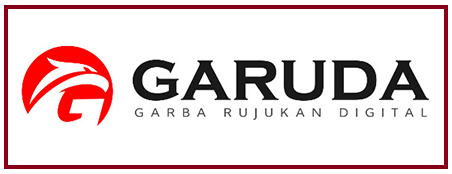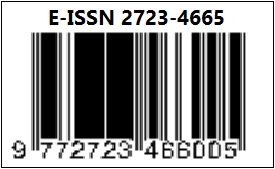The Portrait of Creativity in Using Posters as an Interesting Learning Medium in Grammar Classes: A Narrative Inquiry Study on EFL Teachers
DOI:
https://doi.org/10.55681/jige.v5i2.2683Keywords:
Teacher creativity, Technological literacy, Poster, Learning medium, Grammar classesAbstract
Teacher creativity supported by the use of technology can be achieved by making posters as a Grammar learning medium that can provide significant benefits to students’ success in learning English. This study aimed to reveal the teachers’ perceptions and experiences in fostering creativity through making posters as a Grammar learning medium. This research used a qualitative approach with a 'narrative inquiry' design. The subjects of this study consisted of three teachers from an English learning institution in Malang, Indonesia. This study used depth interviews as an instrument. The results of this study showed that the teachers’ activity through making posters as a learning medium for 'Grammar' grew through three elements consisting of flexibility, originality, and curiosity. The use of posters could also increase productivity and foster technological literacy for teachers. Meanwhile, posters were also able to increase students’ Grammar understanding and learning motivation better. In short, posters had a great positive impact in creating an interesting and fun learning environment. Thus, it is expected that teachers have the ability to make posters as a medium for learning English.
Downloads
References
Awaludin, F. A., Abd Karim, R., & Mohd Saad, N. H. (2017). A digital collaborative tool for academic writing. Journal of Education and Social Sciences, 8(1), 179-184. https://www.jesoc.com/wp-content/uploads/2017/12/KC8_84.pdf
Bhalla, J. (2012). Study of barriers to use computers by school teachers in teaching and learning process. Journal of Educational and Social Research, 5(6), pp. 259-276. https://Doi:10.5901/jesr.2012v2n3p259
Christensen, R. & Knezek, G. (2008). Self-report measures and findings for information technology attitudes and competencies. In Voogt, J. & Knezek, G. (Eds). International handbook of information technology in primary and secondary education. New York: Springer.
Dawson, V. (2008). Use of information communication technology by early career science teachers in Western Australia. International of Science Education, 30(3), pp. 203-219. https://doi.org/10.1080/09500690601175551
Ertmer, P.A., Ottenbreit-Leftwich, A.T., Sadik, O., Sendurur, E. & Sendurur, P. (2012). Teacher beliefs and technology integration practices: A Critical relationship. Computers & Education, 59(2), pp. 423-435. https://doi.org/10.1016/j.compedu.2012.02.001
Greenstein, L. (2012). Assessing 21st century skills: A guide to evaluating mastery and authentic learning. Thousand Oaks: Corwin Press.
Harris, J.B & Hofer, M.J. (2011). Technological pedagogical content knowledge (TPACK) in action: A descriptive study of secondary students’ teacher curriculum-based and technology-related instructional planning. Journal of Research on Technology in Education, 43(3), pp. 211-229. https://www.learntechlib.org/p/54099/
Hett, K. (2012). Technology support literacy in the classroom: Using audiobooks and digital storytelling to enhance literacy instruction. Illinois Reading Council Journal, 40(3), 3–13.
Ibrahim, N. (2016). Games for Teaching Grammar to Young Learners. Indonesian Journal of Integrated English Language Teaching (IJIELT), 2(1), pp. 49-63. DOI: http://dx.doi.org/10.24014/ijielt.v2i1.2366
Kopcha, T.J. (2012). Teachers’ perceptions of the barriers to technology integration with technology under situated professional development. Computers & Education, 59(4), pp. 1109-1121. https://doi.org/10.1016/j.compedu.2012.05.014
Lawrence, A. J., & Lawrence, A. A. (2013). The attitude of student teachers towards using grammar games for teaching English. International Journal on New Trends in Education and Their Implications. 3(2), pp 65-72.
Lee, S.-M. (2019). Her story their own stories? Digital game-based learning, student creativity, and creative writing. ReCALL, 31(3), 238–254. DOI: https://doi.org/10.1017/S0958344019000028
Mart, C.T. (2013). The Grammar-Translation Method and the Use of Translation to Facilitate Learning in ESL Classes. Journal of Advances in English Language Teaching, 1(4), pp. 103-105.
Marlina, N., Dewi, NS., & Supriyono, Y. (2020). Self-directed learning in spoken grammar activities using poster presentation. Research Article, 5(2), pp. 171-176. https://doi.org/10.21070/jees.v5i2.955
Mohamadpur, M. (2013). Effects of peripheral English learning and creating motivation on Iranian secondary school EFL learners of elementary level. Journal of Literature, Languages and Linguistics, 2(1), 44-45.
O.Neill, G. and Jennings, D. (2012). The use of posters for assessment: A guide for staff. UCD Teaching and Learning/ Resources: Dublin. www.ucd.ie/teaching
Osa, J. O. and Musser, L. R. (2004). The role of posters in teacher education programs. Education Libraries, 27(1): 16-21. DOI: https://doi.org/10.26443/el.v27i1.196
Ozturk, O. (2017). Using Poster Presentation to Facilitate EFL Teacher Learning. International Journal of Language Academy, 401–415. DOI : http://dx.doi.org/10.18033/ijla.3719
Prichard, C. and Ferreira, D. (2014). The Effects of Poster Presentations and Class Presentations on Low-Proficiency Learners. TESOL Journal 5, 172–185. https://doi.org/10.1002/tesj.131
Schmidt, D.A., Baran, E., Thompson, A.D., Mishra, P., Koehler, M.J. & Shin, T.S. (2009). Technological pedagogical content knowledge (TPACK) in the development and validation of assessment instruments for preservice teachers. Journal of Research and Technology in Education, 42(2), pp. 123-149. https://doi.org/10.1080/15391523.2009.10782544
Salehi, H. Shojaee, M., & Sattar, S. (2014). Using e-learning and ICT courses in educational environment: A review. English Language Teaching, 8(1), pp. 63-78. https://dx.doi:10.5539/elt.v8n1p63
Syukri, S. & Humaera, I. (2019). Gaining motivation in English learning for special needs of students using flashcards, foldable books, and posters in EFL contexts. LANGKAWI – Journal of the Association for Arabic and English, 5(2), pp. 91-101. DOI: http://dx.doi.org/10.31332/lkw.v5i2.1303
Tanner, P. and Chapman, J. (2012). Poster presentations speak for themselves. JALT, 36 (3), pp. 15-20. https://dx.doi.org/10.37546/jalttlt36.3-3
Wahyuningsih, K. S., Hindu, U., Gusti, N. I., &; Sugriwa, B. (2021). Online Learning Problems during the Covid-19 Pandemic at SMA Dharma Praja Denpasar. PANGKAJA, 24(1), 107–118. https://ejournal.ihdn.ac.id/index.php/PJAH/article/view/2185.
Wilson, A & Christie, D. (2010). Realizing the potential of virtual environments: A challenge for Scottish teachers. In Lindberg, J. & Olofson, A. (Eds). Online learning communities and teacher professional development: Methods for improved education delivery. Hershey, PA.
Yang, X. (2022). Research on digital teaching of creative writing in the context of computer big data. Wireless Communications and Mobile Computing, 2022, 1–9. https://doi.org/10.1155/2022/2699833
Zakaria, R. (2021). Games as warming up activities in the classroom for Indonesian EFL students. International Seminar on Language, Education, and Culture (ISOLEC), 20(1), pp. 266-276. https://doi.org/10.18502/kss.v5i3.8549
Zerin, S., & Khan S. A. (2013). Poster- A visual stimulus for active learning. GSTF International Journal of Law and Social Sciences, 3(1), 129-134. http://dx.doi.org/10.2139/ssrn.3533586
Downloads
Published
How to Cite
Issue
Section
License
Copyright (c) 2024 Ahmad Heki Sujiatmoko, Lestari Setyowati, Elvira Rasyida MR

This work is licensed under a Creative Commons Attribution-ShareAlike 4.0 International License.













